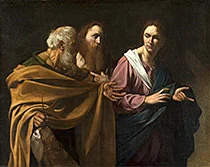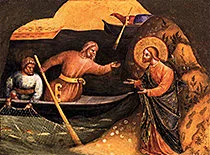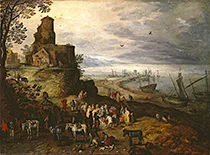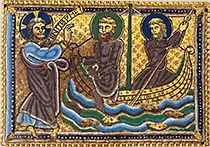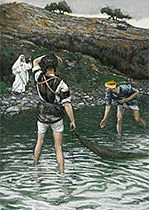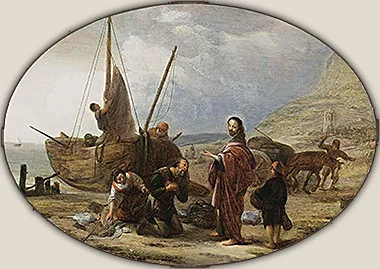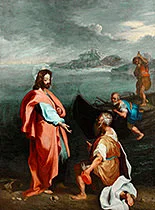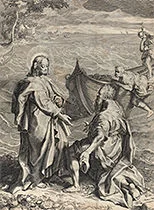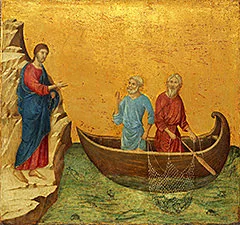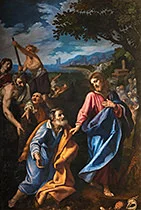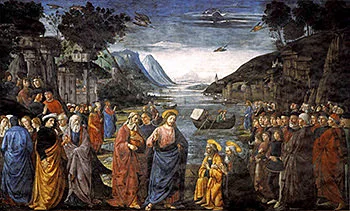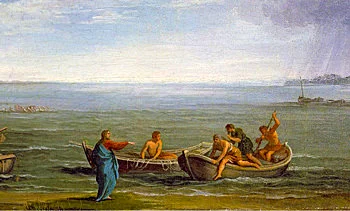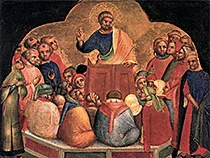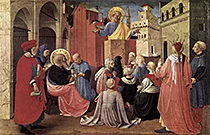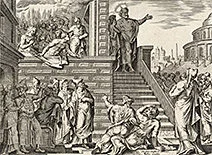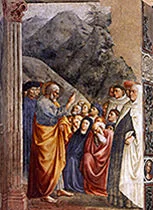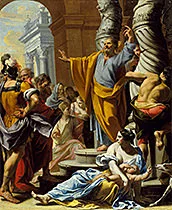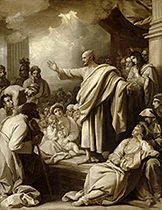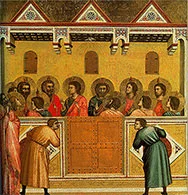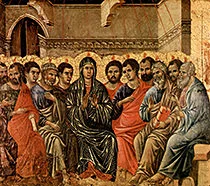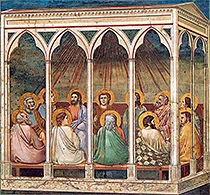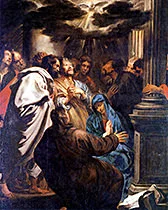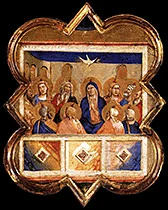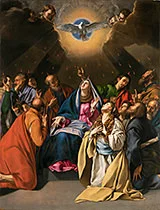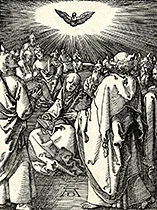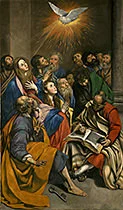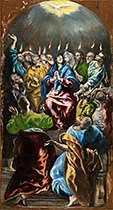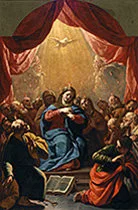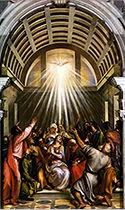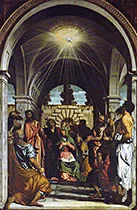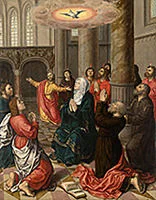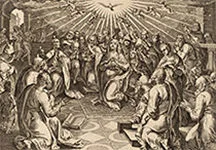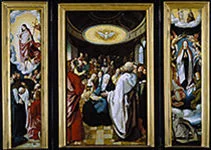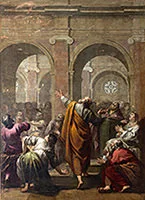The Art World Commemorates Peter
— Album 2 of 17 Photo Albums —
Warren Camp’s presentation of 550 famous “Peter” works of art includes historic paintings, frescoes, stained glass, etchings, sculptures, engravings, and other artwork monuments. They come from the Gothic (1100–1400), High Renaissance, Baroque, Rococo, Neoclassical, and Romantic (1800s) eras.
All are popular works, designed and created by celebrated artists, many of whom you’ll likely recognize, including Rembrandt, Raphael, Michelangelo, El Greco, Da Vinci, Masaccio, Huret, Galle, Tissot, Botticelli, Dürer, Rubens, and many more. They’ll bring back recollections of your “Art History 101” classes, using Janson’s History of Art textbook.
Whether depicting “Cephas,” “Petrus,” “Simon,” “Simeon,” “Simon Bar-Jonah,” “Simon Peter,” “The Rock,” “Peter,” “Apostle Peter,” or “Saint Peter,” the enlarged images of this acclaimed Bible figure come with factual and enlightening details: the artist’s bio; when each work was created; where it can be seen; applicable Bible passages; background and highlights of each work; and photo sources with copyright notices.
To appreciate the impact that Peter had on numerous art-world masters, be sure to click each thumbnail to enlarge it.
• These photo albums complement the Bible-study commentaries Warren has written for “1st and 2nd Peter,” found here.
…
Album 1 (Peter, alone) | Album 2 | Album 3 | Album 4 | Album 5
Album 6 | Album 7 | Album 8 | Album 9 | Album 10 | Album 11
Album 12 | Album 13 | Album 14 | Album 15 | Album 16 | Album 17
Album topics are shown at the [ ⇓ bottom ⇓ ] of each page.
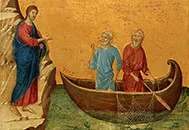
The Calling of Apostles Peter and Andrew
Slide 1
Click to enlarge.
Caravaggio
c. 1603–1606
oil on canvas
Slide 2
Click to enlarge.
Veneziano — c. 1370
oil painted on
poplar panel
Peter and Andrew”
Slide 3
Click to enlarge.
Brueghel the Elder
c. 1608
oil on panel
Peter and Andrew”
Slide 4
Click to enlarge.
unknown
c. 1160–1180
enamel on copper
and Saint Andrew”
Slide 5
Click to enlarge.
Tissot — 1886–1894
watercolor on paper
Slide 6
Click to enlarge.
Jacob de Wet, early 17th century, oil on panel
Slide 9
Click to enlarge.
Duccio di Buoninsegna — 1308–1311
tempera on wood panel
Slide 11
Click to enlarge.
Ghirlandaio — 1481–1482, painted fresco
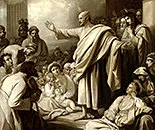
Peter Preaching the Gospel of Jesus
Saint Mark’s Presence”
Slide 14
Click to enlarge.
Fra Angelico — c. 1433
tempera on panel
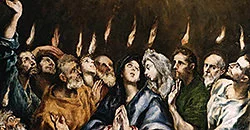
Powerful Pentecost
— The Descent of the Holy Spirit —
- Slide 1. “The Calling of Saints Peter and Andrew,” oil on canvas, painted by Caravaggio, c. 1603–1606
Caravaggio’s “The Calling of Saints Peter and Andrew” “Christ [right] gestures ahead while turning back to the brothers Simon (later named Peter) and Andrew, who have been fishing by the Sea of Galilee. He says, ‘Follow me and I will make you become fishers of men.’ The fishermen’s weather-beaten faces and hands eloquently express astonishment, confusion, and fear.
“The subject of this painting comes from Mark’s Gospel (1:16–18). A young Christ, unusually shown without a beard, gestures out of the painting in the direction in which he is moving, while turning back to the two brothers. Peter holds two fish, skewered on sticks, and starts back in surprise while Andrew points to himself incredulously. The composition seems to imply that Christ will walk calmly off to the right, without looking back again, and that the other two figures (after a due period of astonishment and reluctance) will find themselves following.”[1]
Peter and Andrew began to follow Jesus while John the Baptizer was alive, before Jesus lived in Galilee. Months later, after Jesus had performed many miracles and John the Baptizer had been killed, Jesus told some of the Twelve that he’d make them fishers of people; it’s from that point on that their discipleship intensified. Luke’s gospel account reveals Peter as subsequently being moved to acknowledge personally his sinfulness to Christ, with his brother not far behind (Luke 5:1–11). Caravaggio possibly portrayed Peter and Andrew’s astonishment and confession after being called by Jesus to become fishers of men.[2]
… Height: 55.1 in. (140.1 cm), width: 69.2 in. (176 cm)
… Photo source, license, attribution, museum details, and image enlargement: Caravaggio, public domain, via Wikimedia Commons
… The artist’s short biography; his other works of art
Return to “Peter Masterpieces” album’s opening page or to the top of this page or open the next album. - 2. “Calling Apostles Peter and Andrew,” oil on poplar panel, painted by Lorenzo Veneziano, c. 1370
“Calling Apostles Peter and Andrew” was painted by Lorenzo Veneziano “who fulfilled countless commissions in Venice, including an altarpiece that was later dismembered; the central panel depicting ‘Christ Giving the Keys to St Peter’ is now in Museo Correr, Venice; the side panels were destroyed in Berlin in 1945. The five surviving predella panels are the ‘Conversion of Paul,’ ‘Calling of the Apostles Peter and Andrew,’ ‘Christ Rescuing Peter from Drowning,’ ‘Apostle Peter Preaching,’ and ‘Crucifixion of Peter.’”[1] See Veneziano’s altarpiece paintings in Album 2, 3, 4, and 16.
Simon (his given name) Peter, perhaps the most colorful, outspoken, and brashly human of all Jesus’ early disciples, was one of the first followers of Jesus Christ. “Being a natural-born leader, Peter became the de facto spokesman for the Twelve. More significantly, it was he who first confessed Jesus as being ‘the Christ, the Son of the living God,’ a truth which Jesus said was divinely revealed to Peter (Matthew 16:16–17).”[2]
Brothers Peter and Andrew began to follow Jesus while John the Baptizer was alive, before the Lord lived in Galilee. Months later, after Jesus had performed many miracles and John the Baptizer had been killed, Jesus told some of the Twelve that he’d make them fishers of people; it’s from that point on that their discipleship intensified. Luke’s gospel account reveals Peter as subsequently being moved to acknowledge his sinfulness to Christ, with his brother not far behind (Luke 5:1–11). Here, Veneziano portrays Peter and Andrew, the moment Jesus called both of them to become fishers of men.[3]
… Height: 9.5 in. (24 cm), width: 13 in. (33 cm)
… Photo source, license, attribution, museum details, and image enlargement: public domain, via Web Gallery of Art; Staatliche Museen, Berlin
… The artist’s short biography; his other works of art
Return to “Peter Masterpieces” album’s opening page or to the top of this page or open the next album. - 3. “Fish Market (Calling the Apostles Peter and Andrew),” oil on panel, painted by Jan Brueghel the Elder, c. 1608
“Jan Brueghel (also Bruegel or Brueghel) the Elder was a Flemish painter and draughtsman. He was the son of the eminent Flemish Renaissance painter, Pieter Bruegel the Elder. A close friend and frequent collaborator with Peter Paul Rubens, the two artists were the leading Flemish painters in the first three decades of the 17th century… Jan Brueghel represented the erudite painter whose works are informed by the religious motifs and aspirations of the Catholic Counter-Reformation, as well as the scientific revolution with its interest in accurate description and classification… His realistic depictions of nature in all its various forms, in flowers, landscapes, animals, etc., made it clear that the study of God’s creation was an important source for knowing God.”[1]
“Fish Market (Calling the Apostles Peter and Andrew)” — Painted by Jan Brueghel the Elder, this detailed landscape painting depicts the great fish market in Brussels, Belgium, during the 16th century. Brueghel suggested therein the calling of Peter and Andrew as “fishers of men”[2] by Christ Jesus. This was Jesus’ message to Peter and Andrew: “Follow Me, learn of Me, know and understand My mission and My message. Only then will you be able to be fishers of men.”… Here are three Scriptures about fishing for people: Matthew 4:18–20; Mark 1:16–18; and Luke 5:9–11
While walking by the Sea of Galilee, Jesus approached Peter and Andrew who were fishermen, busy casting nets into the lake. Jesus called out: “Follow me, and I will make you fishers of men” (Matt. 4:19). The New Testament tells us that both men immediately left their nets behind and followed Jesus (v. 20). They already knew who Jesus was; so when he called them to be his disciples, they responded without hesitation.
… Height: 19.2 in. (49 cm), width: 25.9 in. (66 cm)
… Photo source, license, attribution, museum details, and image enlargement: Jan Brueghel the Elder, public domain, via Wikimedia Commons
… The artist’s short biography; his other works of art
Return to “Peter Masterpieces” album’s opening page or to the top of this page or open the next album. - 4. “Plaque with the Calling of Saints Peter and Andrew,” enamel and copper plaque by an unknown artist, c. 1160–1180
“Plaque with the Calling of Saints Peter and Andrew” The Met tells us that “this rare and highly important plaque epitomizes a key moment in the history of medieval art when goldsmiths — who had traditionally used enamels only as a substitute for colored gems — realized the full potential of the technique as a narrative art form. The theatrical nature of the ‘Calling of Saints Peter and Andrew’ comes to life through the use of rich color, sure engraving, dramatic gestures, and intense gazes. The artist represents compelling details as Jesus, standing at the edge of the Sea of Galilee, calls the brothers to be ‘fishers of men.’ Peter gathers up his robe to keep it dry as he steps from the boat, while Andrew pushes with an oar against the waves.”[1]
The unknown artist of this tiny, twelfth-century, gilded-copper plaque presented Christ Jesus’ calling of Peter and Andrew as ‘fishers of men.’[2] Here are three Scriptures about fishing for people: Matthew 4:18–20; Mark 1:16–18; and Luke 5:9–11
Brothers Peter and Andrew began to follow Jesus while John the Baptizer was alive. Months later, after Jesus had performed many miracles and John the Baptizer had been killed, Jesus told some of the Twelve that he’d make them fishers of people; it’s from that point on that their discipleship intensified. Luke’s gospel account reveals Peter as subsequently being moved to acknowledge his sinfulness to Christ, with his brother not far behind (Luke 5:1–11).
… Height: 3 7/16 in. (8.7 cm), width: 4 15/16 in. (12.5 cm), thickness: 1/8 in. (0.3 cm)
… Photo source, license, attribution, museum details, and image enlargement: The Met; The Cloisters Collection, 2013
Return to “Peter Masterpieces” album’s opening page or to the top of this page or open the next album. - 5. “The Calling of Saint Peter and Saint Andrew,” opaque watercolor on gray wove paper, by James Tissot, 1886–1894
[ James Tissot (French, 1836–1902): “The Calling of Saint Peter and Saint Andrew (Vocation de Saint Pierre et Saint André),” 1886–1894. Brooklyn Museum, purchased by public subscription, 00.159.56 (Photo: Brooklyn Museum, 00.159.56_PS1.jpg); see Tissot’s “Life of Christ” collection of 124 watercolors selected from a set of 350 detailed scenes.]
“The Calling of Saint Peter and Saint Andrew” painted by James Tissot “Jesus begins his ministry to the people by calling disciples, or apostles, those who will help him spread his teachings. Peter and Andrew, fishermen on the Sea of Galilee, heed his call at once, leaving behind their nets. Their immediate acceptance of his call to a new life sets the tone for discipleship.
“Intent on giving a wealth of practical detail, Tissot in his commentary on this image describes the method of fishing with nets in the shallows near the shoreline, a practice that would have allowed Peter and Andrew to hear Jesus easily. Believing that little had changed in the Holy Land since Jesus’ time, Tissot equips them much like the fishermen he observed during his visits to the region in the 1880s, with nets worn around the waist to carry the day’s catch.”[1]
The idea behind fishing is to know the fish you are looking for and attract it so you can make the catch. So, what does it mean to be “fishers of men”? An excellent Scripture-based answer can be found on Got Questions Ministries.
… Height: 9 5/8 in. (24.4 cm), width: 6 5/8 in. (16.8 cm)
… Photo source, license, attribution, museum details, and image enlargement: Brooklyn Museum
… The artist’s short biography; his other works of art
Return to “Peter Masterpieces” album’s opening page or to the top of this page or open the next album.
- 6. “The Calling of Saint Peter and Saint Andrew,” oil on panel, painted by Jacob de Wet the Elder, early 17th century
“The Calling of Saint Peter and Saint Andrew” It was rare for artists of any century to paint oval productions, whether on walls, ceilings, or panels; Jacob De Wet’s works were predominantly of biblical subjects.
Both Simon Peter and Andrew began to follow Jesus while John the Baptizer was alive, before the Lord lived in Galilee. Months later, after Jesus had performed many miracles and John the Baptizer had been killed, Jesus told some of the Twelve that he’d make them fishers of people; it’s from that point on that their discipleship intensified. Luke’s gospel account reveals Peter as subsequently being moved to acknowledge his sinfulness to Christ, with his brother not far behind (Luke 5:1–11). When Jesus told Andrew and Peter they’d become “fishers of men,” he promised that he’d use them to save men’s souls, which is exactly what the apostles did.
“The phrase ‘fishers of men’ was spoken by Jesus when He was calling two of His disciples, Simon Peter and Andrew, to follow Him. The idea behind fishing is to know the fish you are looking for and attract it so you can make the catch. This was Jesus’ message to Peter and Andrew: ‘Follow Me, learn of Me, know and understand My mission and My message. Only then will you be able to be fishers of men.’”[1]
… Height: 14.5 in. (36.9 cm), width: 20.4 in. (51.7 cm)
… Photo source, license, attribution, museum details, and image enlargement: Jacob Willemsz de Wet, public domain, via Wikimedia Commons
… The artist’s short biography; his other works of art
Return to “Peter Masterpieces” album’s opening page or to the top of this page or open the next album. - 7. “Calling of Saints Peter and Andrew,” oil on canvas, painted by Federico Barocci, 1590–1609
Calling of Saints Peter and Andrew “Federico Barocci (c. 1535 in Urbino – 1612 in Urbino) was an Italian Renaissance painter and printmaker. His original name was Federico Fiori; he was nicknamed Il Baroccio. His work was highly esteemed and influential, and foreshadows the Baroque of Rubens. He is generally considered the greatest and the most individual painter of his time in central Italy.”[1]
Gospel context: In Matthew 4:18–20 and Mark 1:16–18, Jesus had seen Simon and Andrew casting their nets into the sea. He invited them to come with him and become “fishers of men.” Andrew isn’t mentioned in Luke’s somewhat different account of the call (Luke 5:1–11). But in John’s gospel (John 1:35–42), we learn that Andrew is one of two disciples of John the Baptist who decided to follow Jesus; Andrew then recruited his brother Simon, whom Jesus renamed “Cephas,” which is interpreted “Peter.” In this painting, Peter has the same gray hair and short, square beard that he wears elsewhere in early masterpieces. Jesus invites Peter, then Andrew, with an open-hand gesture to become fishers of men. See what Jesus means by “fishers of men.” When Jesus told Andrew and Peter they’d become “fishers of men,” he promised that he’d use them to save men’s souls, which is exactly what the apostles did.
… Height: 52.3 in. (133 cm), width: 38.9 in. (99 cm)
… Photo source, license, attribution, museum details, and image enlargement: Federico Barocci, public domain, via Wikimedia Commons
… The artist’s short biography; his other works of art
Return to “Peter Masterpieces” album’s opening page or to the top of this page or open the next album. - 8. “Christ and Saint Peter,” an engraved print by an unknown artist, 1743–1763
The Metropolitan Museum of Art has determined that the unknown artist who engraved “Christ and Saint Peter” followed the style and concept of Federico Barocci’s work. See the similarities of both pieces by looking at this album’s slide 7 that highlights Barocci’s “Calling of Saints Peter and Andrew,” oil on canvas painting, 1590–1609; similar indeed.
The unknown artist of this engraved print presented Christ Jesus’ calling of Peter and Andrew as “fishers of men.” See all three Scriptures about fishing for people: Matthew 4:18–20; Mark 1:16–18; and Luke 5:9–11
Peter and Andrew began to follow Jesus while John the Baptizer was alive. Months later, after Jesus had performed many miracles and John the Baptizer had been killed, Jesus told some of the Twelve that he’d make them fishers of people; it’s from that point on that their discipleship intensified. Luke’s gospel account reveals Peter as subsequently being moved to acknowledge his sinfulness to Christ, with his brother not far behind (Luke 5:1–11). This artist possibly portrayed Peter and Andrew’s astonishment and confession after being called by Jesus to become fishers of men.
The idea behind fishing is to know the fish you are looking for and attract it so you can make the catch. So, what does it mean to be “fishers of men”? An excellent Scripture-based answer can be found on Got Questions Ministries.
… Height: 21 in. (53.3 cm), width: 14 5/8 in. (37.1 cm)
… Photo source, license, attribution, museum details, and image enlargement: The Met; The Elisha Whittelsey Collection, The Elisha Whittelsey Fund, 1947
Return to “Peter Masterpieces” album’s opening page or to the top of this page or open the next album. - 9. “Calling Apostles Peter and Andrew,” tempera on wood panel, painted by Duccio di Buoninsegna, 1308–1311
Duccio di Buoninsegna, often known as Duccio, was an Italian painter active in Siena (central-Italy’s Tuscany region) in the early 14th century. Throughout his life he’d been commissioned to complete many important government works and several masterpieces in religious buildings in Italy.
“This was one of the rear panels of Duccio’s magnificent Maestà, in Siena Cathedral. [To see many more of Duccio’s Maestà creations that feature Peter, open Warren Camp’s Albums #2, 4, 8, 9, 13, 14, and 15.] With more than fifty individual scenes, the altarpiece was about 14 feet wide and towered to gabled pinnacles some 17 feet over the main altar. It was installed in June 1311, after a triumphant procession through the streets of Siena. Priests, city officials, and citizens were followed by women and children ringing bells for joy. Shops were closed all day and alms were given to the poor. Duccio, like all artists of his time, was regarded as a craftsman and was often called on to paint ceiling coffers, parade shields, and the like. Not until the middle and later fourteenth century did the status of artists rise.”[1]
“This small panel, part of the Maestà, was one of the most important masterpieces in the history of Western painting. The monumental Maestà was a two-sided altarpiece that dominated the main altar in Siena’s cathedral for nearly two centuries. Within the vast black-and-white-striped interior of the church, it would have glittered in the colored light that washed down through stained glass. Completed in less than three years, the Maestà was a huge undertaking, for which Duccio received 3,000 gold florins [worth $428,000 today] — more than any artist had ever commanded.”[2]
… Height: 16 13/16 in. (42.7 cm), width: 17 15/16 in. (45.5 cm)
… Photo source, license, attribution, museum details, and image enlargement: National Gallery of Art; Samuel H. Kress Collection
… The artist’s short biography; his other works of art
Return to “Peter Masterpieces” album’s opening page or to the top of this page or open the next album.
- 10. “Calling of Peter and Andrew,” oil on canvas, by Ludovico Cigoli, 1607
Ludovico Cigoli herein presents Jesus meeting two fishermen, Simon and Andrew, on Lake Tiberias’s shore, inviting both to leave their fishing career behind and follow him. This is a pivotal episode in the general accounts of all four gospels. It highlights the start of Jesus’ preaching and becomes the foundation for Christianity’s future.
Essentially, Cigoli’s oil-on-canvas composition, with its softly shaded blues and pinks, earnestly presents the personalities of Jesus, Peter, and Andrew, within an extremely clear narrative: We viewers can clearly identify and appreciate the passion of the moment while sensing the intensity of the looks shared by the Master and his disciple, Peter, revealing both the life-changing request that Jesus had made and the certain, affirmative response of the mere fisherman who’d readily agreed to become “fishers of people.” The idea behind fishing is to know the fish you are looking for and attract it so you can make the catch. So, what does it mean to be “fishers of people or men”? An excellent Scripture-based answer can be found on Got Questions Ministries.
Calling of Peter and Andrew “This work was painted in 1607 for nobleman Niccolò Carducci, agent of the Grand Duke Ferdinand I, in Livorno, Italy, and destined for the chapel in the cathedral of that city. It’s one of the most stunning works by the artist and also one of his last, since he died in 1608.”[1]
… Height: 12.1 ft. (370 cm), width: 7.9 ft. (239 cm)
… Photo source, license, attribution, and image enlargement: public domain, via Web Gallery of Art; Galleria Palatina (Palazzo Pitti), Florence
… The artist’s short biography; his other works of art
Return to “Peter Masterpieces” album’s opening page or to the top of this page or open the next album. - 11. “Vocation of the First Apostles,” fresco, painted by Domenico Ghirlandaio, 1481–1482
Vocation of the First Apostles “is a fresco by the Italian Renaissance painter Domenico Ghirlandaio, executed in 1481–1482 and located in the Sistine Chapel, Rome. It depicts the gospel narrative of Jesus Christ calling Peter and Andrew to become his disciples.”[1]
“This fresco in the Sistine Chapel is from the cycle of Jesus’ life. In accordance with Pope Sixtus IV’s wishes in the early 1480s, there were in each picture several episodes of a story presented together, a practice that by this time was already becoming outdated. Two frescoes that Ghirlandaio painted were this ‘Vocation of the Apostles’ and the ‘Resurrection.’”[2]
At the center of this fresco, Christ is blessing the kneeling, haloed brothers, Simon Peter and Andrew, his first disciples. Ghirlandaio has also placed Jesus in the background (right of center), standing near a fishing boat on the bank, saying to two other haloed men, “Follow me and I will make you fishers of men.”[3] There we see Christ calling brothers James and John, who are sitting in that boat, mending their nets with their father, Zebedee. James and John immediately became Jesus’ apostles (Matthew 4:21–22).
… Height: 11.5 ft. (349 cm), width: 18.7 ft. (570 cm)
… Photo source, license, attribution, museum details, and image enlargement: Domenico Ghirlandaio, public domain, via Wikimedia Commons
… The artist’s short biography; his other works of art
Return to “Peter Masterpieces” album’s opening page or to the top of this page or open the next album. - 12. “The Calling of Saint Peter and Saint Andrew,” oil on canvas, painted by Pietro da Cortona, c. 1626–1630
Pietro da Cortona was an Italian Baroque painter and architect. Along with his contemporaries and rivals, he was one of the key figures in the emergence of Roman Baroque architecture. He was also an important designer of interior decorations who decorated churches and palaces with spectacular frescoes that seemed to make ceilings and walls disappear and interiors expand. Pietro’s beautiful landscape painting is currently housed at The Fitzwilliam Museum, Cambridge, UK. This Baroque artist is more commonly celebrated for his stunning fresco ceilings at the Barberini and Pitti palaces… Explore how this small-but-stunning oil-on-canvas painting was created by watching this video clip from Christian Art.
At the center of “The Calling of Saint Peter and Saint Andrew,” Christ stands on the shore in front of an approaching fishing boat. He calls two brothers — Simon Peter and Andrew — to become his first disciples, inviting them, “Follow me and I will make you fishers of men.” Perhaps the others still sitting in the boats are brothers James and John, sons of Zebedee, who Matthew tells us became Jesus’ apostles immediately after he called them (Matthew 4:21–22).
“Simon Peter, also known as Cephas, was an outspoken and ardent disciple, one of Jesus’ closest friends, an apostle, and a “pillar” of the church. He was enthusiastic, strong-willed, and impulsive. No matter his strengths and several failings, the Lord chose to continually mold Peter into the exact follower he wanted Peter to be. Through all of Peter’s ups and downs, Lord Jesus remained Peter’s loving Lord and faithful Guide.”[1]
… Height: 11.2 in. (28.7 cm), width: 22.5 in. (57.4 cm)
… Photo source, license, attribution, museum details, and image enlargement: Pietro da Cortona, public domain, via Wikimedia Commons
… The artist’s short biography; his other works of art
Return to “Peter Masterpieces” album’s opening page or to the top of this page or open the next album. -
• That ends “The Calling of Peter and Andrew” …
• Now begins “Peter Preaches the Gospel of Jesus”
13. “Apostle Peter Preaching,” oil on poplar panel, painted by Lorenzo Veneziano, c. 1370“Apostle Peter Preaching” was painted by Lorenzo Veneziano who fulfilled countless commissions in Venice, including an altarpiece that was later dismembered; the central panel depicting ‘Christ Giving the Keys to St Peter’ is now in Museo Correr, Venice; the side panels were destroyed in Berlin in 1945. The five surviving predella panels are the ‘Conversion of Paul,’ ‘Calling of the Apostles Peter and Andrew,’ ‘Christ Rescuing Peter from Drowning,’ ‘Apostle Peter Preaching,’ and ‘Crucifixion of Peter.’”[1] See Veneziano’s altarpiece paintings in Album 2, 3, 4, and 16.
Veneziano herein presents Saint Peter, preaching in Jerusalem. According to Luke’s account in Acts, Peter preached: “Repent and be baptized, every one of you, in the name of Jesus Christ … Save yourselves from this corrupt generation.” Read the entire passage: Acts 2:38–41. On the day of Pentecost, Peter was the main speaker to the crowd in Jerusalem. Despite his being threatened, beaten, and arrested, Peter remained committed and “never stopped teaching and proclaiming the good news that Jesus is the Messiah” (Acts 5).
… Height: 9 1/2 in. (24 cm), width: 13 in. (33 cm)
Return to “Peter Masterpieces” album’s opening page or to the top of this page or open the next album.
… Photo source, license, attribution, and image enlargement: public domain, via Web Gallery of Art; Staatliche Museen, Berlin
… The artist’s short biography; his other works of art
- 14. “Saint Peter Preaching in Saint Mark’s Presence,” tempera on panel, painted by Fra Angelico, c. 1433
Fra Angelico’s “Saint Peter Preaching in Saint Mark’s Presence” This artist “combined the influence of the elegantly decorative International Gothic style of Gentile da Fabriano with the more realistic style of such Renaissance masters as Masaccio and sculptors Donatello and Ghiberti, all of whom worked in Florence. Angelico was also aware of the theories of perspective proposed by Leon Battista Alberti. Angelico’s representation of devout facial expressions and his use of colour to heighten emotion are particularly effective. His skill in creating monumental figures, representing motion, and suggesting deep space through the use of linear perspective, especially in the Roman frescoes, mark him as one of the foremost painters of the Renaissance.”[1]
Biblically we find no text documenting Peter’s preaching in Mark’s presence. Nevertheless, Peter took Mark to be his travel companion and interpreter, writing down some of Peter’s sermons. Luke, in his second volume — Acts — presents Peter preaching a significant message to a crowd in Jerusalem where he told people that their Spirit-created tongues were a fulfillment of Scripture, a sign that the “last days” had begun; following up he declared that people can be saved (Acts 2:14–21). He then explained that: (1) David had predicted the Messiah’s resurrection; (2) the apostles had witnessed Jesus’ resurrection; and (3) the exalted Jesus had begun to pour out the Holy Spirit on his people.
… Height: 15 1/3 in. (39 cm), width: 22 in. (56 cm)
… Photo source, license, attribution, museum details, and image enlargement: public domain, via Web Gallery of Art; Museo di San Marco, Florence
… The artist’s short biography; his other works of art
Return to “Peter Masterpieces” album’s opening page or to the top of this page or open the next album. - 15. “Peter Speaks to the People about Christ,” engraved by Philip Galle, 1550–1570
This engraved print titled “Peter Speaks to the People about Christ” was created by Flemish artist Philip Galle (1537–1612), after Maerten van Heemskerck. It was presented in a series of engravings titled “Acts of the Apostles,” a series of thirty-four plates depicting the New Testament book of Acts. It shows the dramatic effects of Peter’s (and fellow apostles’) preaching to the people of Jerusalem, exhorting the Jews to repent and convert to Christianity.
The Bible reference that motivated Galle to create this detailed engraving is shown in the center of its footer: “Ac. Cap. 2.14” for Acts 2:14.
Luke, in his second volume — Acts — presents Peter preaching a significant message to a crowd in Jerusalem where he told people that their Spirit-created tongues were a fulfillment of Scripture and a sign that the “last days” had begun; he followed up by declaring that people can be saved (Acts 2:14–21). He then explained that: (1) David had predicted the Messiah’s resurrection; (2) the apostles had witnessed Jesus’ resurrection; and (3) the exalted Jesus had begun to pour out the Holy Spirit on his people. Read the entirety of Peter’s very powerful Pentecost sermon in Acts 2:14–47.
… Height: 8 1/4 in. (210 mm), width: 10 2/3 in. (270 mm)
… Photo source, license, attribution, museum details, and image enlargement: National Gallery of Art, CC0, via Wikimedia Commons
… The artist’s short biography; his other works of art
… There are seventeen Galle engravings of Apostle Peter in “Peter Masterpieces”: Album 3 (3@); 5 (4@); 6 (2@); 7 (5@); 10 (2@); and 14.
Return to “Peter Masterpieces” album’s opening page or to the top of this page or open the next album. - 16. “Saint Peter Preaching,” painted fresco by Masolino da Panicale, 1426–1427
Masolino da Panicale’s “Saint Peter Preaching” fresco “is part of the cycle depicting the story of Saint Peter’s life. The scene refers to Peter’s sermon, as recounted in Acts [Luke’s second volume], where he preached in Jerusalem after the descent of the Holy Spirit on the day of Pentecost. The fresco illustrates the final part of the sermon when Peter replied, ‘Repent and be baptized, every one of you, in the name of Jesus Christ for the forgiveness of your sins. And you will receive the gift of the Holy Spirit’ (Acts 2:38 NIV).”[1]
“On view at the Brancacci Chapel (The Church of Santa Maria del Carmine in Florence, Italy), a number of other frescoes had begun to be painted by Renaissance masters Masaccio and Masolino and were completed by Filippino Lippi in 1487; they served as a training ground and inspiration to a generation of painters from Raphael to Michelangelo. Two layers of frescoes commissioned in 1424 by Felice Brancacci, a wealthy Florentine merchant and statesman, illustrate the life of St Peter, shown in his orange gown.”[2] Read the entirety of Peter’s very powerful Pentecost sermon in Acts 2:14–47.
… Height: 8.4 ft. (255 cm), width: 5.3 ft. (162 cm)
… Photo source, license, attribution, museum details, and image enlargement: public domain, via Web Gallery of Art
… The artist’s short biography; his other works of art
… See two additional Masolino fresco paintings in our “Peter Masterpieces” Album 5: “The Healing of the Cripple” and “The Raising of Tabitha.”
Return to “Peter Masterpieces” album’s opening page or to the top of this page or open the next album. - 17. “St Peter Preaching in Jerusalem,” oil on canvas, painted by Charles Poërson, 1642
Charles Poërson was a Baroque painter from France. Born in 1609, he lived for 58 years. “Having painted this “St Peter Preaching in Jerusalem” in May 1642, Poërson was a pupil of Simon Vouet, painter to King Louis XIII, and very famous in Paris around 1630–1640. The sense of movement, the play of the hands, and the draperies painted by Vouet are major influences for Poërson.”[1]
When the people in Jerusalem first heard the apostles speaking in a variety of languages, they were astonished, assuming that the men were full of wine, early in the morning. But Peter explained to them that these men weren’t drunk, as had been supposed, but this was what Prophet Joel had spoken of when he said, “No, this is what was spoken by the prophet Joel, ‘In the last days, God says, I will pour out my Spirit on all people’” (Acts 2:1–21, citing Joel 2:28–32).
You can read the entirety of Peter’s very powerful Pentecost sermon in Acts 2:14–47 NIV.
… Height: 30 in. (76.2 cm), width: 24.2 in. (61.6 cm)
… Photo source, license, attribution, and image enlargement: Los Angeles County Museum of Art, public domain, via Wikimedia Commons
… The artist’s short biography; his other works of art
Return to “Peter Masterpieces” album’s opening page or to the top of this page. or open the next album - 18. “St Peter’s First Sermon in the City of Jerusalem,” oil on canvas, painted by Benjamin West, c. 1785
In this sharply detailed Benjamin West painting titled “St Peter’s First Sermon in the City of Jerusalem,” Peter “the saint giving the first sermon at Pentecost, standing on steps in front of pillars, arms outstretched, right hand in blessing; the apostles stand behind him, with Saint John to his left; in the crowd a mother with two young children at Peter’s front-right listen.”[1]
American artist, West (born 1738), portrayed Peter herein as he preached to the crowd at Pentecost. The apostles who’d been anointed by the Holy Spirit stand immediately behind Peter as he addresses the multitude of interested people of all ages. We see what appears to be smoke hovering about the people, reminiscent of the tongues of flame that settled upon the apostles when they assembled in their safe upper room.
On the day of Pentecost, Peter was the main speaker to the crowd in Jerusalem (Acts 2:14–21), and the Church began with an influx of about 3,000 new believers (v. 41). Thereafter, he preached fearlessly before the Sanhedrin (Acts 4). Read the entirety of Peter’s Pentecost sermon in Acts 2:14–47.
… Height: 36 in. (91.4 cm), width: 28 in. (71.1 cm)
… Photo source, license, attribution, museum details, and image enlargement: Benjamin West, public domain, via Wikimedia Commons
… The artist’s short biography; his other works of art
Return to “Peter Masterpieces” album’s opening page or to the top of this page or open the next album. -
• That ends “Peter Preaches the Gospel of Jesus” …
• Now begins “Pentecost: Descent of the Holy Spirit”
19. “Pentecost,” egg tempera on poplar wood, painted by Giotto di Bondone, 1310–1318Giotto di Bondone, known mononymously as Giotto, was an Italian painter and architect from Florence during the Late Middle Ages. In his works, human beings are the exclusive subject matter, acting with dedicated passion their parts in the great Christian drama of sacrifice and redemption.
“This small painting of the miraculous Pentecost event shows Giotto’s skill at transforming complex biblical stories into images that were easy to decipher. Jesus’ followers were gathered together fifty days after his crucifixion to celebrate the Jewish Feast of Weeks. A strong wind began to blow and flames like ‘tongues of fire’ appeared on their heads. They were filled with the Holy Spirit and began to miraculously speak a number of languages so all in their presence could understand. A white dove, representing the Holy Spirit, appeared directly beneath the central gable.
In this egg tempera painting titled “Pentecost,” “Giotto solved the problem of illustrating the narrative clearly by using a low wall to divide those experiencing the event and those straining to hear what was going on. The symmetrical arrangement of the figures focuses our attention on the dove.”[1]
On the day of Pentecost, Peter was the main speaker to the crowd in Jerusalem (Acts 2:14–21). As a result, the Church began with an influx of about 3,000 souls being added to the fellowship, the breaking of bread and praying, apostolic signs and wonders, and a community in which everyone’s needs were met (v. 45). Read the entirety of Peter’s very powerful Pentecost sermon (vv. 14–47).
… Height: 17.9 in. (45.5 cm), width: 17.3 in. (44 cm)
… Photo source, license, attribution, museum details, and image enlargement: The National Gallery, London; bequeathed by Geraldine Emily Coningham
… The artist’s short biography; his other works of art
Return to “Peter Masterpieces” album’s opening page or to the top of this page or open the next album. - 20. “Pentecost,” tempera on wood, painted by Duccio di Buoninsegna, 1308–1311
Duccio’s “Pentecost” “This scene is on one of the back crowning panels of the Maestà of Duccio (1308–1311), an altarpiece composed of many individual paintings commissioned by the city of Siena in 1308 from Duccio di Buoninsegna; it’s perhaps his most famous work. The painting ornamented Cathedral of Siena’s high altar until 1505. Later the predella pictures were separated; the original frame was lost. [See photo enlargements of the Maestà’s front and rear. [To see many more of Duccio’s Maestà creations that feature Peter, open Warren Camp’s Albums #2, 4, 8, 9, 13, 14, and 15.]
“In his Pentecost altarpiece painting, Duccio went back to using traditional iconographic schemes by including the Virgin Mary, the mother of Jesus, in its center. Although he and many other artists resorted to traditionally featuring Mary in the Pentecost story, there’s no specific mention of her in Acts 2, the sole source of the Pentecost episode. Here, Mary’s entire figure, illuminated by the highlights of her robe, becomes a form with strongly curved outlines contrasting with the loose drapery of the disciples’ garments. The succession of halos echoes the group in a shining golden frame. The panel has obviously been cut on the left side, where the twelfth apostle is missing; only the red ray descending from above remains.”[1]
… Height: 15 in. (38 cm), width: 16.9 in. (43 cm)
… Photo source, license, attribution, and image enlargement: public domain, via Web Gallery of Art; Museo dell'Opera del Duomo, Siena, Italy
… The artist’s short biography; his other works of art
Return to “Peter Masterpieces” album’s opening page or to the top of this page or open the next album. - 21. “Pentecost,” fresco painted by Giotto, 1304–1306
Giotto di Bondone (c.1267–1337), known mononymously as Giotto, was a painter and architect, active in Florence at the close of the Late Middle Ages and the dawn of the Italian Renaissance. Perhaps his most influential masterpiece is the fresco cycle executed for the Scrovegni (Arena) Chapel in Padua, Italy. There, “The Life of Christ” is a series of seven paintings in tempera and gold, on panel, attributed to Giotto, dating c. 1320–1325. Depicting various elements of the Nativity and Passion of Christ, including “Pentecost,” they’re now housed in a number of museums, as listed here.
“Pentecost” is from ‘The Life of Christ’ series. Here we see the haloed disciples sit and converse with one another beneath an arched structure. Giotto presents the Holy Spirit as rays of sun setting upon Jesus’ disciples, miraculously enabling them to speak other languages. It’s the story of Pentecost in Jerusalem that signals the arrival of God’s eschatological (or final) salvation (Acts 1:4–8; 2:13–36).
Peter was the main speaker to the crowd in Jerusalem on the day of Pentecost. As a result, the Church began with an influx of about 3,000 souls being added to the fellowship, plus the breaking of bread and praying, apostolic signs and wonders, and a community in which everyone’s needs were met (v. 45). Read Peter’s entire powerful sermon in Acts 2:14–47.
… Height: 6.6 ft. (200 cm), width: 6.1 ft. (185 cm)
… Photo source, license, attribution, museum details, and image enlargement: public domain, via Web Gallery of Art
… The artist’s short biography; his other works of art
Return to “Peter Masterpieces” album’s opening page or to the top of this page or open the next album. - 22. “Outpouring of the Holy Spirit,” oil on canvas, painted by Anthony van Dyck, 1618–1620
Anthony van Dyck’s “Outpouring of the Holy Spirit” “The model for this painting of St Peter [center, looking upward] attended the Antwerp guild of artists: Abraham Grapheus. His expressive outward appearance frequently attracted the attention of artists including Cornelius de Vos, Martin de Vos, and Jacob Jordaens.”[1]
“In ‘Outpouring of the Holy Spirit’ (aka ‘Pentecost’), Anthony van Dyck presented the pentecostal miracle described in the New Testament (Acts 2:1–4). At Pentecost, the apostles gathered and were filled with the Holy Spirit so that they began to preach in other languages. The dark room in this painting is illuminated only from above by a divine light — the dove of the Holy Spirit — hovering above the moved apostles. Small flames have settled atop their heads as a sign of their receiving the Holy Spirit. The painting is shown in the Sanssouci Picture Gallery in Pottsdam, Germany.”[2]
“When the day of Pentecost came, the twelve apostles and several disciples were all together in one place. Suddenly a sound like the blowing of a violent wind came from heaven and filled the whole house where they were sitting. They saw what seemed to be tongues of fire that separated and came to rest on each person’s head. All of them were filled with the Holy Spirit and began to speak in other tongues as the Spirit enabled them” (Acts 2:1–4 NIV). Read the entirety of Peter’s very powerful Pentecost sermon in vv. 14–47.
… Height: 8.7 ft. (265 cm), width: 7.25 ft. (221 cm)
… Photo source, license, attribution, museum details, and image enlargement: Anthony van Dyck, public domain, via Wikimedia Commons
… The artist’s short biography; his other works of art
Return to “Peter Masterpieces” album’s opening page or to the top of this page or open the next album. - 23. “Pentecost,” painted on walnut wood by Taddeo Gaddi, 1335–1340
“Taddeo Gaddi’s ‘Pentecost’ and ‘Saint Francis Restoring a Boy to Life’ are each confined within quatrefoils. The panels are part of a series of twenty-six (originally in the sacristy of Santa Croce, Florence), twenty-two are in Munich, and two in Accademia Gallery, Florence.”[1]
Putting “Pentecost” into context: Also known as “Birthday of the Church,” Pentecost is chock full of religious significance, although it’s a holiday not widely celebrated. Pentecost is a bigger deal in liturgical churches, which follow a formal, scripted, standardized order of events. Starting fifty days after the end of Passover for the Jews, Pentecost literally means “fifty.” It commemorates the day the Holy Spirit descended on the twelve apostles and several disciples of Jesus, enabling each of them to suddenly and miraculously be able to speak foreign languages so all those God-fearing Jews in Jerusalem, who were from more than a dozen countries, could understand the gospel message in their own language.
“When the day of Pentecost came, the twelve apostles and several disciples were all together in one place. Suddenly a sound like the blowing of a violent wind came from heaven and filled the whole house where they were sitting. They saw what seemed to be tongues of fire that separated and came to rest atop each person’s head. All of them were filled with the Holy Spirit and began to speak in other tongues as the Spirit enabled them” (Acts 2:1–4 NIV). Read the entirety of Peter’s very powerful Pentecost sermon (vv. 14–47).
… Height: 13.8 in. (35 cm), width: 10.6 in. (27 cm)
… Photo source, license, attribution, museum details, and image enlargement: public domain, via Web Gallery of Art; Staatliche Museen, Berlin
… The artist’s short biography; his other works of art
Return to “Peter Masterpieces” album’s opening page or to the top of this page or open the next album. - 24. “Pentecostés,” oil on canvas, painted by Fray Juan Bautista Maíno, 1615–1620
“Shortly after Fray Juan Bautista Maíno painted his earlier ‘Pentecost’ [see slide 26] for the high altar of the church of San Pedro Mártir in Toledo, Maíno executed this second version titled “Pentecostés.” Done on a larger scale and in a wider format, it allowed him to position the fourteen figures in the scene in a balanced manner… The upper part of the canvas includes a large white dove seen frontally with its wings outstretched. Around it is a luminous burst of light that breaks up the intense darkness among which the heads of five cherubim are visible. The Dove of the Holy Spirit is the origin of the small tongues of flame that can be seen hovering over the heads of the depicted figures, all of whom observe the miracle in a restrained manner.”[1]
“When the day of Pentecost came, the twelve apostles and several disciples were all together in one place. Suddenly a sound like the blowing of a violent wind came from heaven and filled the whole house where they were sitting. They saw what seemed to be tongues of fire that separated and came to rest atop each person’s head. All of them were filled with the Holy Spirit and began to speak in other tongues as the Spirit enabled them” (Acts 2:1–4 NIV). Read all of Peter’s very powerful Pentecost sermon in Acts 2:14–47.
… Height: 10.6 ft. (324 cm), width: 8.1 ft. (246 cm)
… Photo source, license, attribution, museum details, and image enlargement: Juan Bautista Mayno, public domain, via Wikimedia Commons
… The artist’s short biography; his other works of art
Return to “Peter Masterpieces” album’s opening page or to the top of this page or open the next album. - 25. “The Descent of the Holy Spirit,” woodcut on paper, from “The Small Passion” series by Albrecht Dürer, c. 1510
Albrecht Dürer’s “Descent of the Holy Spirit” “Dürer studied the technique of woodcuts as an apprentice under Michael Wolgemut, an excellent teacher whose woodcuts then were some of Europe’s best. Dürer typically provided design sketches to artisans who cut his sketches into the wood. In 1496, he began creating a series of twelve woodcuts depicting the death of Christ titled ‘Large Passion,’ which took fifteen years to complete.”[1]
“This is an impression without text from a series of thirty-seven woodcuts about Pentecost. In its center, Virgin Mary [of whom no mention is made in Acts 2, the source of the Pentecost episode], with an open book, sits surrounded by disciples, all of whom have small tongue-like flames on their heads. In the sky, a dove represents the Holy Spirit.”[2]
Biblical text describes the coming of the Holy Spirit: “When the day of Pentecost came, they were all together in one place. 2Suddenly a sound like the blowing of a violent wind came from heaven and filled the whole house where they were sitting. 3They saw what seemed to be tongues of fire that separated and came to rest on each of them. 4All of them were filled with the Holy Spirit and began to speak in other languages as the Spirit enabled them” (Acts 2:1–4). Read all of Peter’s powerful Pentecost sermon in Acts 2:14–47.
… Height: 4.1 ft. (126 cm), width: 3.1 ft. (95 cm)
… Photo source, license, attribution, museum details, and image enlargement: Albrecht Dürer, public domain, via Wikimedia Commons
… The artist’s short biography; his other works of art; Dürer’s collection of thirty-six “Small Passion” woodcuts and twelve “Large Passion” woodcuts
Return to “Peter Masterpieces” album’s opening page or to the top of this page or open the next album. - 26. “Pentecostés,” oil on canvas, painted by Fray Juan Bautista Maíno, 1612–1614
On Pentecost, Christians celebrate the descent of the Holy Spirit upon those apostles who’d gathered in the upper room in Jerusalem; today, the event marks the beginning of the Church. Pentecost’s story is found in Acts 2:1–4, shown below. A gospel account, John 20:19–23, also recounts how Jesus gave the gift of the Holy Spirit to his disciples. Jesus fulfilled his promise to send to his disciples a helper who’d enable them to be his witnesses throughout the world.
Maíno’s large altarpiece painting titled “Pentecostés” presents the Holy Spirit — a helper and advocate — as a dove descending and resting on Jesus’ apostles. “The traditional hierarchical arrangement generally located Mary at the centre, symmetrically flanked by the Apostles. Maíno, however, chose to shift Mary towards the left in the middle-ground, close to and slightly behind the Magdalen, who is here presented as another member of the group of Apostles. As a result, the two most striking and important figures are Saint Peter [left, dropping his key] and Saint Luke in the foreground.”[1]
The term “Pentecost,” meaning “fifty” in Greek, is derived from a gathering of Jesus’ followers, fifty days after his crucifixion, to celebrate the Jewish Feast of Weeks. Here’s the biblical text for Pentecost: “When the day of Pentecost came, they were all together in one place. 2Suddenly a sound like the blowing of a violent wind came from heaven and filled the whole house where they were sitting. 3They saw what seemed to be tongues of fire that separated and came to rest on each of them. 4All of them were filled with the Holy Spirit and began to speak in other languages as the Spirit enabled them” (Acts 2:1–4).
… Height: 9 ft. 4 in. (285 cm), width: 5 ft. 4 in. (161 cm)
… Photo source, license, attribution, museum details, and image enlargement: Juan Bautista Maíno, public domain, via Wikimedia Commons
… The artist’s short biography; his other works of art
Return to “Peter Masterpieces” album’s opening page or to the top of this page or open the next album. - 27. “Pentecost,” oil on canvas, painted by El Greco, c. 1600
“Pentecost” by El Greco “This work depicts the moment the Holy Spirit, in the form of flames, rests on Virgin Mary and the apostles on Pentecost day in Jerusalem. The bald, bearded apostle who looks out at the viewer from the right of the canvas [top row] has been identified as a self-portrait, or as a portrait of the artist’s friend, Antonio de Covarrubias. El Greco painted the scenes [of this altarpiece] in small spaces, emphasizing vertical format, bathing them in a ghostly light that enhances the unreality of the figures, which are arranged in a very marked foreshortening and have very expressive features.”[1]
According to Scripture, the Holy Spirit came down upon Jesus’ disciples in the form of a dove. “Tongues of flame” emanate from the dove and rest atop each disciple’s head. Thereafter, every disciple began to speak the numerous languages of all in their presence, allowing them to effectively spread the teachings of Jesus Christ to many, throughout the world. Note: Although El Greco (and many other artists) resorted to using traditional iconographic schemes that include Virgin Mary, it’s important to realize that there’s absolutely no mention of her in Acts 2, the sole source of the Pentecost episode.
“Pentecost,” meaning “fifty” in Greek, is derived from a gathering of Jesus’ followers, fifty days after his crucifixion, to celebrate the Jewish Feast of Weeks. Pentecost is a main subject of Christian religious art. You can find numerous “Pentecost” masterpieces on this page, compliments of Wikidata. You can also read all of Peter’s Pentecost sermon (Acts 2:14–47).
… Height: 108.2 in. (275 cm), width: 50 in. (127 cm)
… Photo source, license, attribution, museum details, and image enlargement: El Greco, public domain, via Wikimedia Commons
… The artist’s short biography; his other works of art
Return to “Peter Masterpieces” album’s opening page or to the top of this page or open the next album. - 28. “Pentecostés,” oil on canvas, painted by Antonio Palomino, 1696–1705
“Pentecostés” Antonio Palomino The account of Pentecost in Luke’s Acts is filled with powerful imagery. The Holy Spirit overcomes the confines of the upper room where the disciples are gathered and, with the sound of wind and the appearance of tongues of fire, descends on each of them. Immediately the disciples overcome their timidity and go out to preach Jesus’ gospel to every nation, as the Lord had commanded them to do (Acts 1:8). Looking forward to the promise of the Holy Spirit in Christ’s last words on earth before his ascension into heaven, Pentecost signals the beginning of the Church Age.
According to Scripture, the Holy Spirit came down upon Jesus’ disciples in the form of a dove. “Tongues of flame” emanate from the dove and rest atop each disciple’s head. Thereafter, every disciple began to speak the numerous languages of all in their presence, allowing them to effectively spread the teachings of Jesus Christ to many, throughout the world. Note: Although Palomino (and many other artists) resorted to using traditional iconographic schemes that include Jesus’ mother, Mary, often centered, it’s important to realize that there’s no specific mention of her in Acts 2, the sole source of the Pentecost episode.
“Pentecost” means “fifty” in Greek. Annually it falls on the 7th Sunday or 50 days or 7 weeks after Jesus’ resurrection. The first weekly Sabbath after Passover was called The Feast of First Fruits. After Peter had been filled with the Holy Spirit on Pentecost, he became the spokesman for the disciples. He gave his first sermon that appears word for word in Acts 2:14–47.
… Height: 64 1/2 in. (164 cm), width: 42 1/2 in. (108 cm)
… Photo source, license, attribution, museum details, and image enlargement: Antonio Palomino, public domain, via Wikimedia Commons
… The artist’s short biography; his other works of art
Return to “Peter Masterpieces” album’s opening page or to the top of this page or open the next album. - 29. “Pentecost,” oil on canvas, painted by Titian, 1546
“Pentecost” (Italian: Discesa dello Spirito Santo) was painted made by Tiziano Vecellio, whom we refer to as Titian. It’s part of the ‘Descent of the Holy Spirit’ altarpiece in the Basilica of Santa Maria della Salute, Venice. “A disciple of Giorgione, Titian was one of the best exponents of the Venetian Renaissance School of painting. The image presents the descent of the Holy Spirit. Under a half-barrel vault with a coffered ceiling appears the dove that symbolizes the Holy Spirit. From it rays of light spread over the figures gathered beneath. In the center sits Virgin Mary, looking up with her hands joined in prayer. She’s surrounded by six apostles on each side; behind her, Titian painted two women — probably Mary Magdalene and Mary, the wife of Clopas. Tongues of fire appear on the heads of the characters.”[1] … See this Titian “Pentecost” painting on a postage stamp from Guyana.
Note: Although Titian (and many other artists) resorted to using traditional iconographic schemes that include Jesus’ mother, Mary, often centered, it’s important to realize that there’s no specific mention of her in Acts 2, the sole source of the Pentecost episode.
Although the Pentecost story is found in Acts 2:1–4, shown below. A gospel account, John 20:19–23, also recounts how Jesus gave the gift of the Holy Spirit to his disciples. Jesus fulfilled his promise to send to his disciples a helper, an advocate, who’d enable them to be his witnesses throughout the world.
… Height: 18 ft. 6 in. (570 cm), width: 8 ft. 6 in. (260 cm)
… Photo source, license, attribution, museum details, and image enlargement: Titian, public domain, via Wikimedia Commons
… The artist’s short biography; his other works of art
Return to “Peter Masterpieces” album’s opening page or to the top of this page or open the next album. - 30. “Pentecost,” oil on canvas, painted by Moretto da Brescia, 1543
Moretto’s large, oil-on-canvas painting titled “Pentecost,” presents the Holy Spirit — a helper and advocate — in the likeness of a dove descending and resting on the heads of Jesus Christ’s twelve apostles. “The traditional hierarchical arrangement generally located Mary at the center, symmetrically flanked by the apostles.”[1]
On Pentecost, Christians celebrate the Holy Spirit’s descent upon those apostles who’d gathered in Jerusalem’s upper room; today’s event marks the Church’s beginning. The Pentecost story is found in Acts 2:1–4, shown below. A gospel account, John 20:19–23, also recounts how Jesus gave the gift of the Holy Spirit to his disciples. Jesus fulfilled his promise to send to his disciples a helper, an advocate, who’d enable them to be his witnesses throughout the world.
The term “Pentecost,” meaning “fifty” in Greek, is derived from a gathering of Jesus’ followers, fifty days after his crucifixion, to celebrate the Jewish Feast of Weeks. Here’s the biblical text for Pentecost: “When the day of Pentecost came, they were all together in one place. 2Suddenly a sound like the blowing of a violent wind came from heaven and filled the whole house where they were sitting. 3They saw what seemed to be tongues of fire that separated and came to rest on each of them. 4All of them were filled with the Holy Spirit and began to speak in other languages as the Spirit enabled them” (Acts 2:1–4). Read all of Peter’s powerful Pentecost sermon in vv. 14–47.
… Height: 98 in. (249 cm), width: 65 3/4 in. (167 cm)
… Photo source, license, attribution, museum details, and image enlargement: Moretto da Brescia, public domain, via Wikimedia Commons
… The artist’s short biography; his other works of art
Return to “Peter Masterpieces” album’s opening page or to the top of this page or open the next album. - 31. “Pentecost,” an anonymous oil-on-panel painting, 1520–1525
The anonymous painter who created this “Pentecost” painting was a follower of Bernard van Orley. In the Scriptures, the spirit of God, symbolized by tongues of flame on the disciples’ heads, which provide the miraculous speaking in foreign tongues, enabled people from various language groups to understand the message of the apostles. This scene of the disciples at Pentecost associates the commencement of the Holy Spirit’s work in the church with the conclusion of Christ’s earthly ministry, which started three years before his crucifixion.
As told in the New Testament (Acts 2:1–4), the Holy Spirit came down upon Jesus’ disciples in the form of a dove. In this painter’s portrayal, “tongues of flame” emanate from a white dove above, inside a Greek-styled chamber adorned with Ionic marble columns. The tongues of flame rest atop each disciple’s head. Note: Although this artist and many others resorted to using traditional iconographic schemes that include Jesus’ mother, Mary, centered, there’s no specific mention of her in Acts 2, the sole source of the Pentecost episode. You can read all of Peter’s powerful Pentecost sermon in vv. 14–47.
“Pentecost,” meaning “fifty” in Greek, is derived from a gathering of Jesus’ followers, fifty days after his crucifixion, to celebrate the Jewish Feast of Weeks. Pentecost is a main subject of Christian religious art. You can find numerous “Pentecost” masterpieces on this page, compliments of Wikidata.
… Height: 46 7/8 in. (119 cm), width: 36 3/4 in. (93.5 cm)
… Photo source, license, attribution, museum details, and image enlargement: Art Institute of Chicago, public domain, via Wikimedia Commons
Return to “Peter Masterpieces” album’s opening page or to the top of this page or open the next album. - 32. “Pentecost,” an engraved print after Jan van der Straet, by Philip Galle, 1550–1570
Philip Galle’s “Pentecost” engraving, made to follow a Johannes Stradanus work, is included in his “Acts of the Apostles” engravings series.
In this engraving’s center, Galle traditionally placed Mary, Jesus’ mother. Note: Although he (and many other artists) resorted to using traditional iconographic schemes that include Mary, there’s no specific mention of her in Acts 2, the sole source of the Pentecost episode, as cited in the center of his footer’s caption: “Acto.2.1.” She sits surrounded by disciples, all of whom have small tongue-like flames on their heads, enabling them to be able to speak the gospel of Jesus — in several languages — to many people in the collection of cultures there in their community who miraculously understood the message. Peter, with keys on his belt, kneels directly in front of her, with arms open, seeing the approaching dove that represents the Holy Spirit who enables this miracle.
Herein, Galle highlighted the Pentecost-specific biblical text of “tongues of fire that rested on everyone,” as shown here: “When the day of Pentecost came, they were all together in one place. 2Suddenly a sound like the blowing of a violent wind came from heaven and filled the whole house where they were sitting. 3They saw what seemed to be tongues of fire that separated and came to rest on each of them. 4All of them were filled with the Holy Spirit and began to speak in other languages as the Spirit enabled them” (Acts 2:1–4).
… Height: 8 1/4 in. (210 mm), width: 10 2/3 in. (270 mm)
… Photo source, license, attribution, museum details, and image enlargement: National Gallery of Art; Ailsa Mellon Bruce Fund
… The artist’s short biography; his other works of art
… There are seventeen Galle engravings of Apostle Peter in “Peter Masterpieces”: Album 3 (3@); 5 (4@); 6 (2@); 7 (5@); 10 (2@); and 14.
Return to “Peter Masterpieces” album’s opening page or to the top of this page or open the next album. - 33. “The Descent of the Holy Spirit,” oil on panel, painted by Lucas van Leyden, 1530
“Descent of the Holy Spirit” The Dutch painter and very accomplished engraver, Lucas van Leyden, put in the center panel of this triptych, his interpretation of the descent of the Holy Spirit (Acts 2:1–41). According to Scripture, the Holy Spirit came down upon Jesus’ disciples in the form of a dove. “Tongues of flame” emanate from the dove and rest atop each disciple’s head. Every disciple then began to speak numerous languages to all in their presence, effectively spreading the teachings of Jesus Christ to many, throughout the world. Note: Although Lucas van Leyden (and many other artists) resorted to using traditional iconographic schemes that include Mary, Jesus’ mother, there’s no specific mention of her in Acts 2, the sole source of the Pentecost episode.
“The composition of scene in this central Pentecost-specific panel was copied from a woodcut that Albrecht Dürer made in 1511 [see slide 25]. Van Leyden created extra depth by putting two apostles in the foreground; both seem to be looking upward at the dove.”[1]
“Pentecost,” meaning “fifty” in Greek, is derived from a gathering of Jesus’ followers, fifty days after his crucifixion, to celebrate the Jewish Feast of Weeks. The Pentecost is a main subject of Christian religious art. You can find numerous “Pentecost” masterpieces on this page, compliments of Wikidata. And you can read Peter’s very powerful Pentecost sermon (vv. 14–47).
… Height: 20.9 in. (53 cm), width: 23.6 in. (60 cm)
… Photo source, license, attribution, museum details, and image enlargement: WikiArt; Museum Catharijneconvent, Utrecht
… The artist’s short biography; his other works of art
Return to “Peter Masterpieces” album’s opening page or to the top of this page or open the next album. - 34. “The Descent of the Holy Spirit,” painted by Jacques Blanchard, 1634
Jacques Blanchard was 34 when he painted this canvas. Critics recognized in him the talent of a promising painter. He completed his “The Descent of the Holy Spirit” in May of 1634. In the Scriptures, the spirit of God, symbolized by tongues of flame, blows on the disciples.
In Acts chapters 1 and 2, we learn that about 120 followers of Jesus were gathered in prayer in an upper room in Jerusalem. They’d recently seen Jesus ascend and return to his Father in heaven. While the believers were gathered, the Holy Spirit came upon them with flames of fire and a violent wind, because the Spirit had begun to empower the church body for the mission Jesus had given them in Acts 1:8: “You will receive power when the Holy Spirit comes on you; and you will be my witnesses in Jerusalem, and in all Judea and Samaria, and to the ends of the earth.”
According to Scripture (Acts 2:1–4), the Holy Spirit came down upon Jesus’ disciples in the form of a dove. In Blanchard’s portrayal, “tongues of flame” emanate from above, in front of the backdrop of Greek-style architecture, adorned with Ionic columns. The tongues of flame haven’t yet rested atop each disciple’s head. Note: Although Blanchard (and many other artists) resorted to using traditional iconographic schemes that include Mary [far right], there’s no specific mention of Jesus’ mother in Acts 2, the sole source of the Pentecost episode.
… Height: 11 ft. 1 in. (340 cm), width: 8 ft. 1 in. (245 cm)
… Photo source, license, attribution, museum details, and image enlargement: Jacques Blanchard, public domain, via Wikimedia Commons
… The artist’s short biography; his other works of art
Return to “Peter Masterpieces” album’s opening page or to the top of this page or to the start of Warren Camp’s next page: Album 3.
“Peter” Has Indeed Left an Artistic Mark on Our World
In these albums, see numerous “Peter Masterpieces” created by renowned art masters from around the world.
• Album 1: “Peter, Alone” (29 images)
• Album 2: “Calling Apostle Peter” (12@), “Preaching the Gospel” (6@), and “Powerful Pentecost” (16@)
• Album 3: “Peter’s Presence with Other Apostles” (28@) and “Walking on Water” (7@)
• Album 4: “Receiving the Keys of Heaven” (15@), “Transfiguration” (8@), and “Tribute Money” (14@)
• Album 5: “Peter Heals People” (23@) and “The Miraculous Catch of Fish” (13@)
• Album 6: “Peter Gets Freed from Prison” (30@)
• Album 7: “Miscellaneous New Testament Depictions of Peter” (35@)
• Album 8: “Christ Washes Peter’s Feet” (26@)
• Album 9: “The Last Supper — Part 1” (33@ of 136)
• Album 10: “The Last Supper — Part 2” (35@ of 136)
• Album 11: “The Last Supper — Part 3” (34@ of 136)
• Album 12: “The Last Supper — Part 4” (34@ of 136)
• Album 13: “Christ’s Agony in the Garden” (32@)
• Album 14: “Judas’ Kiss,” “Jesus’ Betrayal,” and “Malchus’ Ear” (36@)
• Album 15: “Peter Denies Knowing Christ” (32@)
• Album 16: “Repentant Peter” (17@) and “Peter’s Martyrdom/Crucifixion” (17@)
• • • And, in Album 17, see “Stained Glass Windows Featuring Saint Peter” (34@)
Intro Videos: “First Peter” and “Second Peter”
† Watch this summary video of “First Peter” created by BibleProject.
† Here’s the “Second Peter” summary video created by BibleProject.
• Special Presentation: See more than sixty of Warren Camp’s “Peter Masterpieces” on this 4-minute video clip titled “Holy Week through 100 Paintings,” produced by Christian Art.
